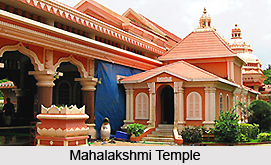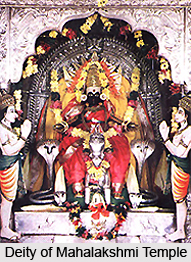 Mahalakshmi Temple is located in the heart of Panaji, the capital city of Goa. It is 4 kilometres from Ponda in the village Bandora. Shri Nagesh Maharoudra Temple is destined approximately 300 meter apart. The presiding deity of the temple is Shri Mahalaxmi, the Hindu goddess of wealth. The idol bears a striking resemblance to the goddess at Kolhapur, the main centre of worship. The temple was built in 1818 with the help of contributions made by devotees. The other presiding deities of the temple are Shri Narayan, Shri Baleshwar, Shri Ravalnath and Shri Narayan Purush. This place was earlier known as `Bandiwad` or `Bandivadem.` Mahalaxmi is the Goddess of power and strength. She is believed to be an incarnation of `Adishakti`-the supreme power and energy. The deity of Goddess Laxmi is considered as the original Goddess of the Shakta sect.
Mahalakshmi Temple is located in the heart of Panaji, the capital city of Goa. It is 4 kilometres from Ponda in the village Bandora. Shri Nagesh Maharoudra Temple is destined approximately 300 meter apart. The presiding deity of the temple is Shri Mahalaxmi, the Hindu goddess of wealth. The idol bears a striking resemblance to the goddess at Kolhapur, the main centre of worship. The temple was built in 1818 with the help of contributions made by devotees. The other presiding deities of the temple are Shri Narayan, Shri Baleshwar, Shri Ravalnath and Shri Narayan Purush. This place was earlier known as `Bandiwad` or `Bandivadem.` Mahalaxmi is the Goddess of power and strength. She is believed to be an incarnation of `Adishakti`-the supreme power and energy. The deity of Goddess Laxmi is considered as the original Goddess of the Shakta sect.
Due to Portuguese invasion construction of Hindu temple was not permitted in Goa for a long time. However, in 1818 the construction of this temple was approved after much delay. The original structure of the temple has undergone renovations several times.
History of Sri Mahalakshmi Temple:
According to a legend the Brahmins from Karwar Kumtha who lived on begging alms used to worship goddess Mahalakshmi. They carried the idol of Mahalakshmi along with them whenever they went. Upon being informed about the conversion policy of Portuguese, they shifted the deity from Taleigo village to the palatial house, opposite the Adilshahi Palace in the heart of Panjim. After that the deity was moved to Mayem village of the Bicholim Taluka in 1817.
They took the deity to Panaji and hid it in a particular place. Later on they sought permission from the liberal Portuguese governor Conde De Rio Pardo of constructing a temple. The permission was granted on 2nd July 1818.
 Another legend has it that during the inquisition in 1557, two non-Brahmins, Sapta and Phato, carried the Utsava idol in a box. However the granite idol was broken by the Portuguese. Sapta and Phato sailed along the Arabian Sea crossed the Rasai River and reached Talawal or Durbat in Atrunja. There they handed over the idol to the Bhandiwade Mahalaxmi Temple. Sapta and Phato were rewarded by the Goddess who ordered the management to give them each two balls of rice after the mid-day mahapuja.
Another legend has it that during the inquisition in 1557, two non-Brahmins, Sapta and Phato, carried the Utsava idol in a box. However the granite idol was broken by the Portuguese. Sapta and Phato sailed along the Arabian Sea crossed the Rasai River and reached Talawal or Durbat in Atrunja. There they handed over the idol to the Bhandiwade Mahalaxmi Temple. Sapta and Phato were rewarded by the Goddess who ordered the management to give them each two balls of rice after the mid-day mahapuja.
Architecture of Sri Mahalakshmi Temple
The deity of Mahalakshmi in the temple is made of black stone with four hands. These arms hold a sickle, a club, a dagger, and a vessel containing prasad and flowers. Even today the original stone idol at the centre of `Garbhagar` is visible while the small metal idol brought from Kolva is placed in corner. The deity in the temple wears a Linga on her head which is considered peaceful or Satvik form of the goddess. It is placed in a silver canopy.
The temple has a small arched entrance at one end with naubat khana located upstairs and further to this is a village. The entrance of this main building is flanked by a domed octagonal temple tower with two rare domes. There is a new hall designed for dance and musical activities. Every side of the mandapa`s entrance is designed with the images of Lord Hanuman or the Monkey God and Garoda Vishnu`s vehicle, half eagle half man. The doors are admirably carved with images Lord Ganesha on them. A silver arched doorway depicts twenty four wooden panels painted lightly. These display the pictures from Bhagavata Purana along with the story of Lord Krishna and Lord Vishnu`s. The Sabhamandap has a gallery of 18 images, out of 24 images of emanatory aspects of Bhagvata sect, which is considered one of the few galleries of wooden images of Lord Vishnu in India.
Many festivals are celebrated in the temple. The festival of
Mahashivaratra is dedicated to the original deity, while of the Ramnavami is performed in honour of the deity from Colva. On that day, she is placed in the Maharath and taken into procession. Apart from Shri Ram Navami (Chaitra Shud Navami), and Maha Shivaratri Festival in the month of Magha, Shri Mahalakshmi Pratishthapana Day in Vaishakha and Navaratri Festival in the month of Ashwin are also celebrated grandly.











